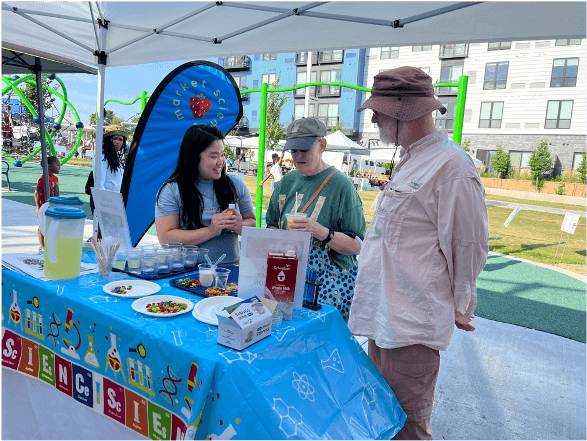Nhu Quach Makes Magic at the Midtown Farmers Market
 During my sophomore year of college, I told my friends about my declared majors: data
science and chemistry. The most common response from my non-science friends was: “Why
do you do it to yourself?”. This anecdote is one of my few examples reflecting on
the notion that to those not in STEM, chemistry, or science in general, is challenging
to logic through, and only few can understand it. Through the STEM Ambassador program
(STEMAP) 2023, I had an opportunity to debunk this myth, convince everyone of its
relevance in our daily lives, and stimulate a curiosity for STEM in young minds.
During my sophomore year of college, I told my friends about my declared majors: data
science and chemistry. The most common response from my non-science friends was: “Why
do you do it to yourself?”. This anecdote is one of my few examples reflecting on
the notion that to those not in STEM, chemistry, or science in general, is challenging
to logic through, and only few can understand it. Through the STEM Ambassador program
(STEMAP) 2023, I had an opportunity to debunk this myth, convince everyone of its
relevance in our daily lives, and stimulate a curiosity for STEM in young minds.
Collaborating with the Market Science from the College of Biological Science at the University of Minnesota (UMN), my fellow volunteers and I set up an outreach event at the Midtown Farmers Market on the Saturday of Labor Weekend. This meant I would have an audience pool of all ages and educational backgrounds. Consequently, I aimed for its theme to be interactive, kid-friendly, and safe to implement but still attractive to adult visitors. Therefore, I designed the outreach event, “Chemistry of Colors,” featuring two hands-on activities: “Magic Lemonade” and “M&M/Skittles Diffusion,” with the addition of a free take-home experiment kit. This event aimed to show participants that chemistry can be sensational and easy to implement.
“Magic Lemonade” is based on the pH dependence of anthocyanin, a pigment found in sweet pea flowers. We asked the participants for their predictions before mixing the tea of this flower (clear blue) with lemonade (clear greenish-yellow). Anthocyanin is a natural pH indicator: it turns blue at neutral pH, teal/ green in basic, and purple-pink at acidic pH. Hence, to most people’s surprise and excitement, the solution did not turn green when they combined the liquids! The second activity uses the concentration gradient principle of solvents to observe the difference in M&M/ Skittles color diffusion rates in milk vs water. The participants decorated their plates and observed how the color in the candy “escaped” into the liquids and moved toward the center of the plate. The activities were also extended to using soap in the milk sample obtained from the previous experiment. As soon as droplets of soap touch the surface of milk with the candy dyes, the colors burst away from these spots. This phenomenon was explained by the polarity of soap (hydrophilic) and milk (containing fat, which are generally hydrophobic). At the end of the interaction, each participant received an experiment kit with red cabbage powder with detailed instructions and explanations. This experiment replicates the Magic Lemonade experiment to reinforce participants’ learnings, allow them to get creative beyond the given instructions, and share it with their families and friends.
The event was a success in terms of the quantity and quality of the encounters and the satisfaction it brought to the visitors and our team. While inviting our audience, we received a fair amount of resistance from the adults, claiming they were either not science people or too old to learn chemistry. Those who were convinced to try, however, expressed the most excitement and eagerness to learn what happened. They were fascinated by the experiments’ phenomena and intrigued to ask more questions! In addition, we were proud to accommodate three wheelchair users and a visual-impaired individual to learn with us. We attracted 112 participants of all ages; within those, there were 36 kids and 76 adults. Over 20% were intrigued and spent more than 5 minutes at our table. Many of the younger audiences were initially drawn in by the candy and cold lemonade on that hot morning, but they stayed for the extra fun! We received a lot of positive comments from the audience, as well as optimistic reactions to the take-home kit. The enthusiasm from our participants was a rewarding prize for all our efforts. Through this process, I learned to be flexible with the audience from the encounters and to be more aware of plastic waste in future event designs.
This public engagement could only be completed with the training and funding from the STEMAP program and the logistics and funding support from UMN Market Science. Special thanks to Victoria Russell and Andrew George for their ideas and comments on the planning, preparing, and implementing processes. I also want to thank Professor Matt Neurock and Mayank Tanwar for their tremendous help at the market site.
About the Blog
Discussion channel for insightful chat about our events, news, and activities.
Categories
Featured Posts
Tag Cloud
- UoG (2)
- Guam (2)
- ethnobotany (1)
- environmental policy (1)
- student immersion (1)
- engineering (1)
- Virgin Islands (1)
- USVI (2)
- lionfish (1)
- children's home (1)
- conservation (1)
- marine ecology (1)
- youth (1)
- sustainability (2)
- Utah (1)
- Arizona (1)
- Nevada (1)
- southwest (1)
- virtual (1)
- project management (1)
- training (1)
- naturalist (1)
- forest (1)
- ecosystem (1)
- Puerto Rico (1)
- Spanish (1)
- library (1)
- Huntington's (1)
- medical science (1)
- Emmanuel Ngwoke (1)
